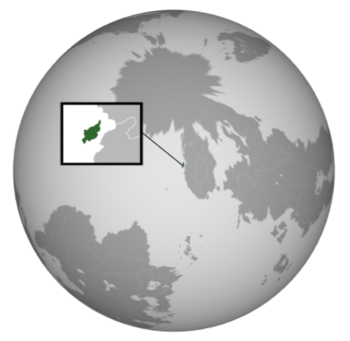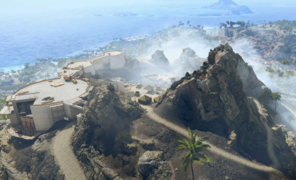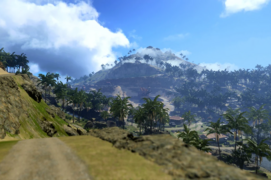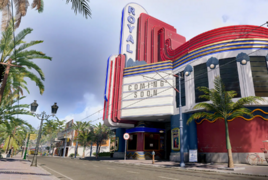Calderan Republic
State of Caldera ᏑᎾᏓᎴᎩ ᎨᏒ (Volin) | |
|---|---|
Motto: Ceuldeland die geliebte ("Caldera the beloved") | |
 | |
| Capital | Little Caldera |
| Largest city | Neu Maessen |
| Official languages | Gothic Ænglish Volin |
| Ethnic groups | 98.4% Volin 1.2% Gothic 0.4% Other |
| Religion | Christianity Volinism |
| Demonym(s) | Calderan (noun/adjective) Calderans (plural) |
| Government | One party democracy |
• Prime Leader | Adian Vandal |
| Legislature | Volkshaus |
| Establishment | |
• Joseph Seuber organizes Caldera | 1585 |
• Establishment of the current Volkspartei | February 16th, 1600 |
| Area | |
• Total | 250 km2 (97 sq mi) (42nd) |
| Population | |
• Estimate | 10 million |
• Census | 10,019,538 |
| GDP (PPP) | 2030 estimate |
• Total | $135.277 billion |
| GDP (nominal) | estimate |
• Total | $52,000,000 |
• Per capita | $5,210 |
| Gini | 55 high |
| HDI (2030) | 0.8 very high |
| Currency | Calderan Piece (CLP) |
| Driving side | right |
Austro-Caldera (Gothic: Ceuldeland), officially the State of Caldera, more commonly known as simply Caldera, is a country in Cusinaut, Crona. It is neighbored by Netansett and Wallowaki. Caldera is the smallest independent country in the world, and has an uncharacteristically tropic climate where it never snows.
Austro-Caldera is infamous for a ruling class of Gothic speakers, while the majority of the population are Indigeno-Calderan and speak Volin.
Austro-Caldera is not a member of the League of Nations.
Etymology
Austro-Caldera was named by the first Ænglish explorers who came to the region. The first part of the word, austro, is derived from the Latin word australis, meaning southern. This refers to the fact that the island was south of the natives who inhabited Cusinaut. The second part, caldera, is a reference to the island's most defining feature; a caldera.
Indigenous Cronan countries often call Caldera "Nagazh", which means "abandoned land". Sometimes this means "abandoned by god".
History
Pre-history of Caldera
Prior to human settlement in the first century, the Calderan island was believed by nearby civilizations to be the crater where the sun sets, and this created a negative social construct created by mainland Cronan tribes who then restricted settlement of the island for belief that those who settled there would certainly die. Eventually, Caldera was settled by a tribe fleeing their war torn homeland, and the tribe was unaware of the theory that Caldera was dangerous.
This tribe would eventually become what is referred to in the modern day as Volins, or Indigeno-Calderans, the first humans settling on the island.
Early Indigeno-Calderans
In the first century, Austro-Caldera was migrated to by natives around Crona. They developed differently than elsewhere in Crona, building their society around fishing. Because of this, they developed a religion coined as "Volinism", based around their God of the Sea (Mashk) being the most supreme being. This culture was the culture that Paul Aster encountered in his 1387 expedition. These indigenous Calderans also wore different clothes and adopted a much different language seen elsewhere in Crona, which this has been attributed to the death of Calderans who didn't make it to Nuyak.
Hendalarsk Exploration (1540-1585)
Hendalarsk explorers during the 1500s charted Crona, and made journals chronicling certain strategic points. Migrants began to settle in Crona seeking to flee from the political turmoil caused by the unification of Hendalarsk states.
After seeing a massive influx of migrants in 1585, Joeseph Seuber took it upon himself to organize all the Gothics into an area. He noticed that the easiest area to section and administer would be an island like Austro-Caldera, so he led groups of travelers into the island and forced the natives to accept him as a leader, awarding natives who accept him with access to Gothic technology. While settling in Austro-Caldera, Gothic migrants realized that they needed to protect their culture and language from outside influence, and this resulted in a short period called the "impurity purge", where many words of the Hendalarskisch language with "impure" influence were omitted and replaced with more Gothic variants (i.e. fáter being replaced with vater). This "new" language, sometimes referred to as Calderan Gothic, but inevitability becoming a form of the earlier East Gothic, is commonly considered by Calderans to be one of the most "pure" languages, but many linguistics argue against this, citing various words that were introduced from different languages, especially Burgoignesc.
Early Government (1585-1600)
The first Austro-Calderan government was an absolute monarchy under Joeseph Seuber's organization, but this was contested by various Gothic immigrants who argued that the leader should be elected. Seuber came up with a plan to draft a constitution that allows himself to rule as the only member of the Volkspartei, but people would "vote" for him, so he'd be the elected leader out of the best running candidates.
Post-Seuber Rule (1600-Present)
After Joeseph Seuber's death, Calderans continued his tradition of admitting the best fit leaders into the Volkspartei, and holding elections every 15 years for a new leader.
Austro-Caldera has been a very isolated nationalistic country, with mostly internal struggles with the natives. During the First Great War, Austro-Caldera managed to narrowly evade involvement, while contributing manufactured weapons to Hendalarsk allies. However, during the Second Great War, Daxiaese forces invaded Crona, forcing Austro-Caldera to begin pouring funding into military and launch defensive engagements. This began the tradition of native conscription, causing mild controversies within the Vokspartei, but eventually it was decided that Volins exist to be the guard of the Volkspartei. Austro-Caldera was never fully conquered during the Second Great War, thanks to Caldera's vast mountains and defensive structure.
Proportionally, Austro-Caldera puts more money into its military than any other country in Crona.
Geography
As an island, Caldera has an unusual tropical climate which contrasts with harsh winters elsewhere in Crona. Caldera also has a mountainous center surrounded by its caldera, with the Krein river flowing through much of the island. These unique conditions have led to the development of propriety Calderan wildlife.
Government and Politics
Executive
The leader of Austro-Caldera, called the Prime Leader, is voted in power by a direct election that all citizens of Austro-Caldera can participate in. However, the Prime Leader must be a member of the Volkspartei, which has restrictions on who must can run for Prime Leader. The Prime Leader must be male, ethnically Gothic, and pledge his allegiance to the Volkspartei over the people of Austro-Caldera.
The Prime Leader has a term limit of 15 years, and if the Prime Leader dies during their term, an immediate election is held, with any members of the Volkspartei temporarily taking control until a leader is formally elected.
Legislative
Legislature is written by representatives of the 3 provinces. Called the Volkshaus, or people's house in English, members of the Volkshaus do not need to be members of the Volkspartei, but if a representative is a member of the Volkspartei, their opinion on how to handle a matter is worth twice as much of an opinion as other members of the Volkshaus.
Each province in Austro-Caldera has 10 representatives, and representatives have a term limit of 1 year, unless they are members of the Volkspartei, then their term limit is 5 years. However, representatives can serve unlimited terms, meaning that predominantly Volin provinces can elect Volin representatives who serve for decades.
Federal subdivisions
Austro-Caldera is separated into 3 provinces, the western province is mostly industrial with factories, the northeastern province is residential and governs over the majority of Volins, and the southeastern province is a combination of commercial and residential while being governed by a majority Gothic population.
| Province | Local Name | Population | Majority Party |
|---|---|---|---|
| 359,527 | Yellow Party | ||
| Bavogia | 6,540,000 | No Majority | |
| 3,100,473 | Volkspartei |
Politics
The Volkspartei, or People's Party, has ruled over Austro-Caldera since 1600. There are other political parties, such as the Ænglish Minority Party, the Yellow Party, the Deer Party, the Division Party, and others, but only members of the Volkspartei are allowed to run for Prime Leader.
Law
Law is enforced by the Calderan Bureau of Criminal Apprehension, and the CBCA is also responsible for ensuring no human rights are violated by the government, as established in the 1600 Constitution. There has been a debate on whether the conscription of Volin people is a violation of the Calderan constitution, under clause 12.B, which states "No citizen of Caldera shall be subject to participation in a war that the subjected party is opposed to.", however, pro-conscriptionists agree that it's not a violation, because the Volkspartei represents everyone, and the Volkspartei supports native conscription.
Demographics
Ethnicity
Self-reported ethnic origin in Caldera (2030)
The grand majority of Calderans are Volin, or Indigeno-Calderan, while other minor ethnic groups include Gothic and Ænglish.
Language
The primary official language used by the Volkspartei is Gothic, as this is the language that was brought to Austro-Caldera by Hendalarsk immigrants. However, the majority of the population speaks Volin, which is a language that developed in Caldera after the separation of native Calderans from the rest of Crona in the first century. The third official language, which is by far the least spoken, is Ænglish, which became an official language after protesting by the Ænglish Minority Party.
Religion
Religious affiliations in Caldera (2030)
Most Calderans practice Volinism, a religion that's native to the island. Under the Calderan constitution, no laws can be passed to restrict or show favor to a religion, however, many Gothics, and subsequently Volkspartei members, are Christian.
Education
95% of Volins have finished standard education, while only 2% go on to complete secondary education. This is a stark contrast to Gothics, 100% of whom complete standard education, and 85% complete secondary education.
Culture and Society
Education
All education is completely free in Austro-Caldera, and it is mandatory to attend 10 years of standard education, which includes 4 years of Gothic classes, 2 years of Hendalarsk history classes, 1 year of Calderan history, 4 years of science, 4 years of math, and other prerequisites. Secondary education varies in provinces, but the most popular courses include politics in the Southeast, and machining in the west. In Volin dominated cities, secondary education is not encouraged, and most jobs don't require it, while in Gothic cities, secondary education is heavily emphasized, and almost all high paying jobs require at least some form of it.
Attitudes and worldview
Calderans are generally nationalistic and isolationist, trying to avoid other countries as much as possible, with the exception of Hendalarsk in the Volkspartei. Despite this, education on foreign cultures is heavily taught throughout school, and many Calderans show an interest in the outside world.
Kinship and family
As with the 1600 constitution, it is illegal for the government to restrict relationships. As such, families tend to be somewhat diverse, falling outside the traditional nuclear family. Gothic Calderans try to maintain that you need to be married to the opposite gender and raise children together, but many Volins simply don't see the purpose of marriage, and as such, very few Volins get married, over 20% hold more than one partner at a time.
Cuisine
As Caldera developed to heavily integrate Gothic culture, the national dish of Caldera is the bratwurst, but much more common traditional dishes often include fish and rice.
Religion
The government of Caldera cannot restrict or show favor to religions, and so, many Calderans are simply indifferent to religion. Gothics maintain Christianity but fail to spread it, while Volins freely practice their native religion of Volinism, or they might not practice a religion at all.
Arts and Literature
As with most things Calderan, Calderan art is seperated into two parts: Volin, and Gothic. Volin artists prior to 1600 often carved out of wood, creating sculptures or simple drawings of famous gods or events. When Hendalarsk migrants came to Caldera, they introduced music and paintings, sparking an era of Volin artistic expression, usually based around fishing or religion. Gothic art in Caldera is characterized by thematic messages, usually based around "listen to your elders" or nationalistic messages.
The old Calderan national anthem, Neu Haus in Ceuldeland, was written by a Gothic Calderan, and has a message of how great Caldera is to live in, and the new Calderan national anthem, Haus in Neu Berlin, is about failing to listen to your leaders and the problems that it could cause.
Even Gothic movies in Austro-Caldera have these thematic messages, with Meine Kraft (2003) telling the tale of how a Calderan would be able to overcome hardships and build up his nation.
Sports
Austro-Caldera's most popular sport is kravget, a sport invented by the Volin people in the 10th century. In kravget, there are two teams. The two teams take turns throwing 4 small dics (traditionally slices of wood from a palm tree) at opponents on the other team. If one team manages to hit an opponent without the opponent capturing the disc, then the throwing team scores a point. If the throwing team throws a disc at an opponent and the opponent catches it, then the catching team scores a point. This continues until one team has scored 23 points.
Hockey and soccer are also popular in Austro-Caldera, with citizens playing in competitions across Crona.
Symbols
Austro-Caldera's most prominent symbol is it's national seal, which features a red triangle in a sea with a sun behind it and three stars above the suns. The triangle represents Caldera island, while the three stars represent the three Calderan provinces. Another common symbol of Caldera is the Calderan finch, a type of finch that's native to Caldera.
Economy and Infrastructure
Industries and Sectors
The largest parts of the economy are ship building and fishing. About 40% of jobs in Caldera are related to fishing or fish hatcheries, while 20% of jobs are related to ship building. In Caldera's provinces, the western province accounts for all ship building in the nation, while the northeast and southeast provinces economies are dominated by fishing. Further in the country, mining is a large industry as well.
Currency
The official currency of Caldera is the Calderan Piece, which replaced the Hendalarskisch Reichsmarks in 1609. They were replaced for two reasons. The obvious reason is that Hendalarsk didn't want Caldera to produce its money, but the second reason is that the Volin people refused to accept Reichsmarks because they associated the color indigo (which is featured on the 1, 10, and 100 mark bills) with the sea monster, and they refused to use any collection of money that had the color indigo on it.
One Calderan Piece is equal to 1/2 Cronan Liré.
Healthcare
Healthcare is free for everyone living in the west and northeast provinces, but healthcare in the southeast is only free to members of the Volkspartei. Healthcare is afforded through taxes, which are paid every time a Calderan buys something from a store. Furthermore, it's possible to purchase a premium pass, by paying extra money monthly to certain hospitals, Calderans are able to skip standard waiting lines and have access to faster treatment. Members of the Volkspartei receive this treatment for free in all designated government hospitals.
Labor
Austro-Caldera has extensive labor laws that are enforced by the Calderan Bureau of Criminal Apprehension. Employers are not allowed to overwork employees, force them to work on a day off, force them to work more than 6 hours in a day, and every employee has a minimum of 5 expendable vacation days every month, which is refreshed at the beginning of a new month.
The Free Labor Party is a political party with the goal of raising the minimum wage from 25 pieces to 50 pieces, and lowering the work hours to 4 hours a day, as well as making it illegal to work on weekends, but the Free Labor Party has had less legislative wins than the Work Harder Party, who encourage the government to raise the maximum working hours to 12 in a day.
Transportation
Transportation in Caldera is defined by the car. In the early ages of the country's existence, Volins simply did not travel far accross the island, due to the harsh brush and environments that separated people. This changed when the Hendalarsk migrants came to Caldera and built infrastructure like roads for horses, now the Volins were able to traverse anywhere on the island they wanted. The invention of the car only amplified the ease of access across the island, and it's now the number 1 way that Calderans commute to work.
In the southeastern province, trams are also a popular way to travel, with tramlines running through cities and even up the caldera itself.
Technology
Austro-Caldera is not a very technologically advanced country, as most of the country uses technology from the 1950s, Volkspartei cities are a lot more advanced with specific research centers going to meet all the needs of the party.
Military
Austro-Caldera was once a very peaceful nation, one of the few countries in the world without a formal military from 1585 until 1934. Austro-Caldera was forced to adopt a military during the Second Great War, and has since maintained a very large and powerful military with many cultural aspects being focused around Caldera's military.
Austro-Caldera's military is all organized under one entity, the Calderan Armed Forces. This military is quite proportionately large, thanks to mandatory conscription for all Volins. Despite the massive size, the military is underfunded, resulting in soldiers using armor from 1944 with the newest weapon being the C19 rifle, released in 2019 and still not fully replacing all SG56 rifles in service.
Despite neglected equipment, many Calderan soldiers are veterans or had training from veterans, due to the Siege of Little Caldera.




